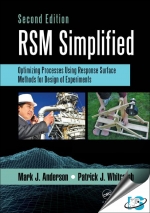Tab Article
Anderson and Whitcomb pick up where they left off in DOE Simplified with RSM Simplified -- a practical tool for design of experiments that anyone with a minimum of technical training can understand and appreciate. Their approach is simple and fun for those who desire knowledge on response surface methods but are put off by the academic nature of other books on the topic.
RSM Simplified keeps formulas to a minimum and makes liberal use of figures, charts, graphs, and checklists. It offers many relevant examples with amusing sidebars and do-it-yourself exercises that will lead readers to the peak potential for their product quality and process efficiency.


